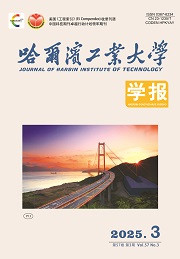| 引用本文: | 王小东,陈明飞,王子文,王燕,王硕,李激.污水生物处理过程中溶解性有机氮分布和转化特征[J].哈尔滨工业大学学报,2020,52(2):161.DOI:10.11918/201812136 |
| WANG Xiaodong,CHEN Mingfei,WANG Ziwen,WANG Yan,WANG Shuo,LI Ji.Distribution and transformation characteristics of dissolved organic nitrogen in wastewater biological treatment process[J].Journal of Harbin Institute of Technology,2020,52(2):161.DOI:10.11918/201812136 |
|
| |
|
|
| 本文已被:浏览 1187次 下载 871次 |

码上扫一扫! |
|
|
| 污水生物处理过程中溶解性有机氮分布和转化特征 |
|
王小东1,陈明飞1,王子文1,王燕1,王硕1,2,3,李激1,2,3
|
|
(1.江南大学 环境与土木工程学院,江苏 无锡 214122; 2.江苏省厌氧生物技术重点实验室(江南大学), 江苏 无锡 214122; 3.江苏省高校水处理技术与材料协同创新中心,江苏 苏州 215009)
|
|
| 摘要: |
| 为研究太湖流域城镇污水处理厂溶解性有机氮(dissolved organic nitrogen,DON)的污染现状及迁移转化规律,选取数座典型污水处理厂(wastewater treatment plants,WWTPs),通过长期水质监测研究出水DON污染水平及其季节变化,并运用多种方法阐明WX-A工艺沿程中DON的分子质量(molecular weight,MW)、亲疏水及荧光光谱变化等特性.结果表明:出水中97.66%~99.22%的含氮化合物为溶解态,DON/溶解性总氮(soluble total nitrogen,STN)为21.88%~26.15%,DON平均质量浓度范围为2.7~3.4 mg/L.厌氧段DON质量浓度出现明显降低趋势,生物膜法(moving bed biofilm reactor,MBBR)工艺段中,分子质量高于30 ku的DON被降解为低于3 ku的DON.出水中低于1 ku的DON比例约为42%,79%的出水DON为亲水性化合物.荧光谱图显示进水DON以酪氨酸类蛋白质和溶解性微生物代谢产物为主要组分,总荧光响应百分比(Pi,n,%)达76.5%,但是进出水中区域Ⅱ(酪氨酸类蛋白质)和区域Ⅳ(溶解性微生物代谢产物)的荧光区域标准体积去除率分别为77.0%和23.7%,进一步表明活性污泥工艺无法实现低分子有机氮的高效去除. |
| 关键词: 污水处理厂 溶解性有机氮 分子质量 三维荧光光谱 荧光响应百分比 |
| DOI:10.11918/201812136 |
| 分类号:X703 |
| 文献标识码:A |
| 基金项目:国家水体污染控制与治理科技重大专项(2017ZX07202-001); 江苏省重点研发计划(社会发展)科技示范工程(BE2015622) |
|
| Distribution and transformation characteristics of dissolved organic nitrogen in wastewater biological treatment process |
|
WANG Xiaodong1,CHEN Mingfei1,WANG Ziwen1,WANG Yan1,WANG Shuo1,2,3,LI Ji1,2,3
|
|
(1.School of Environment and Civil Engineering, Jiangnan University, Wuxi 214122, Jiangsu, China; 2.Jiangsu Key Laboratory of Anaerobic Biotechnology (Jiangnan University), Wuxi 214122, Jiangsu, China; 3.Collaborative Innovation Center of Water Treatment Technology and Material of Jiangsu Colleges, Suzhou 215009, Jiangsu, China)
|
| Abstract: |
| To investigate the pollution status and migration and transformation rules of dissolved organic nitrogen (DON) in urban wastewater treatment plants (WWTPs) of Taihu Basin, several typical WWTPs were selected. Through long-term wastewater quality monitoring of the DON pollution level and seasonal variation, DON molecular weight, hydrophobicity, and fluorescence spectrum characteristics were studied by multiple methods. Experimental results showed that 97.66%-99.22% of effluent nitrogen were dissolved nitrogen compound, and the proportion of DON to soluble total nitrogen (STN) was 21.88%-26.15%, and the average DON concentration ranged from 2.7 to 3.4 mg/L. A significant decrease of DON was observed in anaerobic tank, and the DON with molecular weight higher than 30 ku was degraded to lower than 3 ku after moving bed biofilm reactor (MBBR) process. In the study, 42% of the DON with molecular weight lower than 1 ku was measured within effluent, and 79% of the effluent DON were hydrophilic compounds. Fluorescence spectrum showed that tyrosine-like proteins and soluble microbial metabolites were the main influent DON components, and the total fluorescence response percentage (Pi,n, %) reached 76.5%. However, the removal rates of tyrosine protein and soluble microbial metabolite were 77.0% and 23.7% respectively, which further indicated that the activated sludge process was not suitable to the effective removal of low molecular weight organic nitrogen. |
| Key words: wastewater treatment plants dissolved organic nitrogen molecular weight three dimensional fluorescence spectrum fluorescence response percentage |
|
|
|
|







